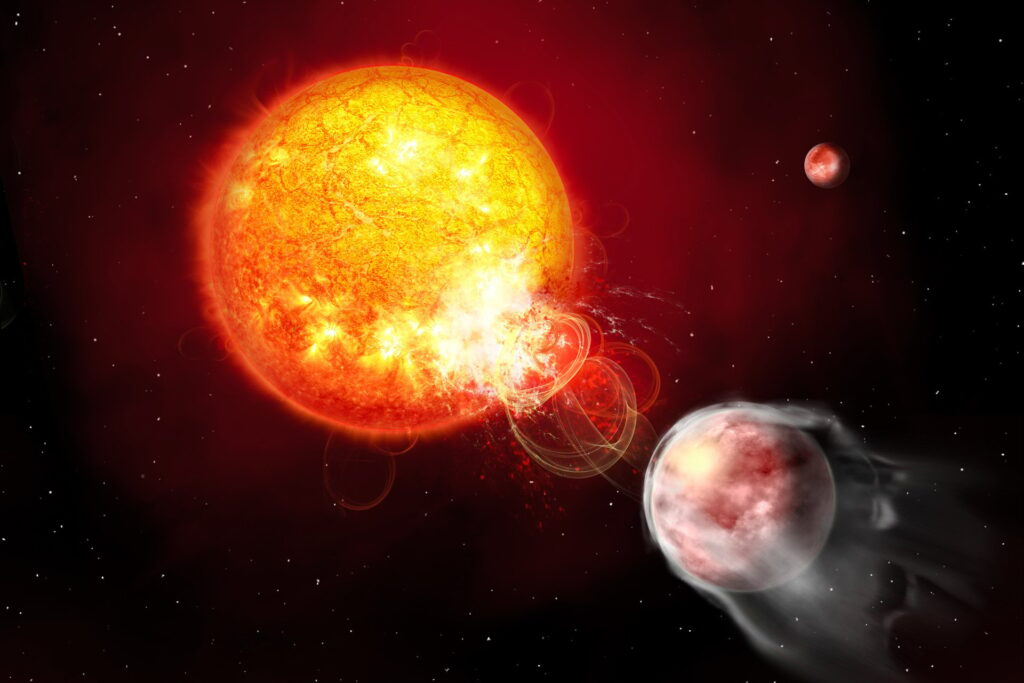A young, energetic star has found itself in a turbulent relationship with its orbiting planet, HIP 67522 b. This cosmic drama unfolds as the planet sends energy waves toward the star, prompting violent explosions that are slowly eroding the planet itself. This discovery was made possible through the European Space Agency’s (ESA) Cheops mission, as a team of astronomers from the Netherlands Institute for Radio Astronomy gathered groundbreaking evidence of this interaction.
Published in the journal Nature, the study reveals that the planet, similar in size to Jupiter, may be triggering unusually powerful flares of radiation from its host star. These flares are approximately 100 times more energetic than previously theorized, marking a significant development in our understanding of star-planet interactions.
The Discovery of a “Death Wish” Planet
HIP 67522 b, characterized by its candy floss-like density, completes an orbit around its star in just seven days. The star, slightly larger and cooler than our Sun, is a mere 17 million years old, a stark contrast to our middle-aged 4.5-billion-year-old Sun. Despite its youth, this star exhibits a more powerful magnetic field and greater energy output.
The initial discovery of this unique system was made using TESS (Transiting Exoplanet Survey Satellite). “We hadn’t seen any systems like HIP 67522 before,” stated Ekaterina Ilin, lead author of the study. “When the planet was found, it was the youngest planet known to be orbiting its host star in less than 10 days.”
Unprecedented Observations with Cheops
To confirm their findings, the astronomers utilized ESA’s CHaracterising ExOPlanet Satellite (CHEOPS) for a closer inspection. “With Cheops, we saw more flares, taking the total count to 15, almost all coming in our direction as the planet transited in front of the star as seen from Earth,” Ilin explained.
These observations suggest that HIP 67522 b may be influencing its host star’s magnetic field, causing the star to release intense bursts of energy. This phenomenon is akin to the solar flares produced by our own Sun, albeit on a much grander scale.
The Science Behind the Flares
Solar flares occur when a build-up of magnetic energy is suddenly released. For HIP 67522 b, its proximity to the star might allow it to gather energy and redirect it as waves along the star’s magnetic field lines. These waves, upon reaching the star’s surface, trigger massive flares.
“The planet seems to be triggering particularly energetic flares,” Ilin noted. “The waves it sends along the star’s magnetic field lines kick off flares at specific moments. But the energy of the flares is much higher than the energy of the waves. We think that the waves are setting off explosions that are waiting to happen.”
The radiation carried by the flares is eroding the planet’s wispy atmosphere and causing it to lose mass at a much faster rate.
Future Implications and Research
In the next 100 million years, HIP 67522 b could shrink from a Jupiter-sized planet to a Neptune-sized one, as the flares continue to strip away its atmosphere. This discovery opens new avenues for understanding how planets and stars interact, especially in young star systems.
The research team plans to conduct follow-up observations using different wavelengths to better understand the types of energy being released by the star. “I have a million questions because this is a completely new phenomenon, so the details are still not clear,” Ilin remarked.
This development represents a significant leap in exoplanetary science, offering a glimpse into the dynamic and often destructive relationships between stars and their planets. As astronomers continue to explore the cosmos, such discoveries will undoubtedly reshape our understanding of the universe.
About The Author
 Energy Tech Summit 2024: Mercury Launch and Innovations in Berlin
Energy Tech Summit 2024: Mercury Launch and Innovations in Berlin Medicaid Cuts Loom: How CIOs Can Innovate to Mitigate Impact
Medicaid Cuts Loom: How CIOs Can Innovate to Mitigate Impact Campaign Urges Action Against Game Publishers Revoking Access
Campaign Urges Action Against Game Publishers Revoking Access Oppo Reno 14: A Comprehensive Look at Features, Specs, and Pricing
Oppo Reno 14: A Comprehensive Look at Features, Specs, and Pricing Buffalo Bills’ Maxwell Hairston Faces Sexual Assault Allegations in Federal Lawsuit
Buffalo Bills’ Maxwell Hairston Faces Sexual Assault Allegations in Federal Lawsuit